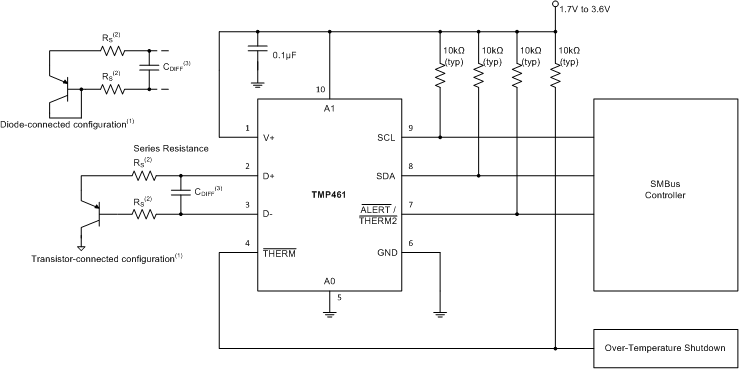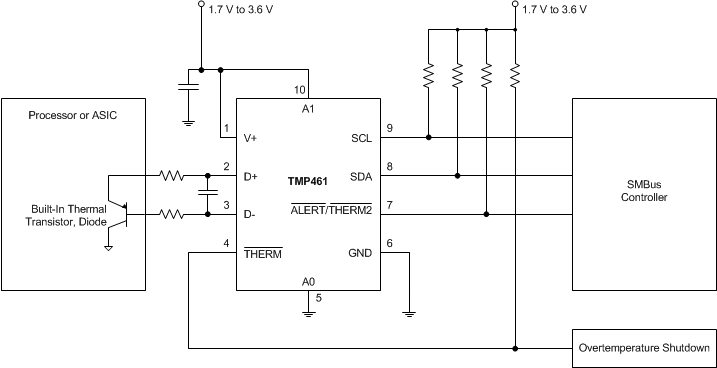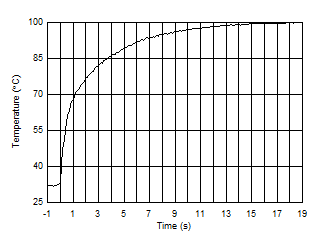ZHCSDW3B June 2015 – August 2016 TMP461
PRODUCTION DATA.
- 1 特性
- 2 应用
- 3 说明
- 4 简化框图
- 5 修订历史记录
- 6 Pin Configuration and Functions
- 7 Specifications
-
8 Detailed Description
- 8.1 Overview
- 8.2 Functional Block Diagram
- 8.3 Feature Description
- 8.4 Device Functional Modes
- 8.5 Programming
- 8.6
Register Map
- 8.6.1
Register Information
- 8.6.1.1 Pointer Register
- 8.6.1.2 Local and Remote Temperature Registers
- 8.6.1.3 Status Register
- 8.6.1.4 Configuration Register
- 8.6.1.5 Conversion Rate Register
- 8.6.1.6 One-Shot Start Register
- 8.6.1.7 Channel Enable Register
- 8.6.1.8 Consecutive ALERT Register
- 8.6.1.9 η-Factor Correction Register
- 8.6.1.10 Remote Temperature Offset Register
- 8.6.1.11 Manufacturer Identification Register
- 8.6.1
Register Information
- 9 Application and Implementation
- 10Power Supply Recommendations
- 11Layout
- 12器件和文档支持
- 13机械、封装和可订购信息
9 Application and Implementation
NOTE
Information in the following applications sections is not part of the TI component specification, and TI does not warrant its accuracy or completeness. TI’s customers are responsible for determining suitability of components for their purposes. Customers should validate and test their design implementation to confirm system functionality.
9.1 Application Information
The TMP461 device requires only a transistor connected between the D+ and D– pins for remote temperature measurement. Tie the D+ pin to GND if the remote channel is not used and only the local temperature is measured. The SDA, ALERT, and THERM pins (and SCL, if driven by an open-drain output) require pullup resistors as part of the communication bus. A 0.1-µF power-supply decoupling capacitor is recommended for local bypassing. Figure 18 and Figure 19 illustrate the typical configurations for the TMP461 device.
9.2 Typical Application

 Figure 19. TMP461 Basic Connections Using a Processor Built-In Remote Transistor
Figure 19. TMP461 Basic Connections Using a Processor Built-In Remote Transistor
9.2.1 Design Requirements
The TMP461 device is designed to be used with either discrete transistors or substrate transistors built into processor chips and application-specific integrated circuits (ASICs). Either NPN or PNP transistors can be used, as long as the base-emitter junction is used as the remote temperature sense. NPN transistors must be diode-connected. PNP transistors can either be transistor- or diode-connected (see Figure 18).
Errors in remote temperature sensor readings are typically the consequence of the ideality factor and current excitation used by the TMP461 device versus the manufacturer-specified operating current for a given transistor. Some manufacturers specify a high-level and low-level current for the temperature-sensing substrate transistors. The TMP461 device uses 7.5 μA for ILOW and 120 μA for IHIGH.
The ideality factor (η) is a measured characteristic of a remote temperature sensor diode as compared to an ideal diode. The TMP461 allows for different η-factor values; see the η-Factor Correction Register section.
The ideality factor for the TMP461 device is trimmed to be 1.008. For transistors that have an ideality factor that does not match the TMP461, Equation 4 can be used to calculate the temperature error.
NOTE
For Equation 4 to be used correctly, the actual temperature (°C) must be converted to Kelvin (K).

where
- TERR = error in the TMP461 device because η ≠ 1.008,
- η = ideality factor of the remote temperature sensor,
- T(°C) = actual temperature, and
In Equation 4, the degree of delta is the same for °C and K.
For η = 1.004 and T(°C) = 100°C:

If a discrete transistor is used as the remote temperature sensor with the TMP461, the best accuracy can be achieved by selecting the transistor according to the following criteria:
- Base-emitter voltage is > 0.25 V at 7.5 μA, at the highest-sensed temperature.
- Base-emitter voltage is < 0.95 V at 120 μA, at the lowest-sensed temperature.
- Base resistance is < 100 Ω.
- Tight control of VBE characteristics indicated by small variations in hFE (that is, 50 to 150).
Based on this criteria, two recommended small-signal transistors are the 2N3904 (NPN) or 2N3906 (PNP).
9.2.2 Detailed Design Procedure
The local temperature sensor inside the TMP461 device monitors the ambient air around the device. The thermal time constant for the TMP461 device is approximately two seconds. This constant implies that if the ambient air changes quickly by 100°C, then the TMP461 device takes approximately 10 seconds (that is, five thermal time constants) to settle to within 1°C of the final value. In most applications, the TMP461 package is in electrical, and therefore thermal, contact with the printed circuit board (PCB), as well as subjected to forced airflow. The accuracy of the measured temperature directly depends on how accurately the PCB and forced airflow temperatures represent the temperature that the TMP461 is measuring. Additionally, the internal power dissipation of the TMP461 can cause the temperature to rise above the ambient or PCB temperature. The internal power dissipated as a result of exciting the remote temperature sensor is negligible because of the small currents used. Equation 6 can be used to calculate the average conversion current for power dissipation and self-heating based on the number of conversions per second and temperature sensor channel enabled. Equation 7 shows an example with local and remote sensor channels enabled and 16 conversions per second; see the Electrical Characteristics table for typical values required for these calculations. For a 3.3-V supply and a conversion rate of 16 conversions per second, the TMP461 device dissipates 0.531 mW (PDIQ = 3.3 V × 161 μA) when both the remote and local channels are enabled.


The temperature measurement accuracy of the TMP461 device depends on the remote and local temperature sensor being at the same temperature as the system point being monitored. If the temperature sensor is not in good thermal contact with the part of the system being monitored, then there is a delay between the sensor response and the system changing temperature. This delay is usually not a concern for remote temperature-sensing applications that use a substrate transistor (or a small, SOT23 transistor) placed close to the device being monitored.
9.2.3 Application Curve
Figure 20 shows the typical step response to submerging a sensor in an oil bath with a temperature of 100°C.
